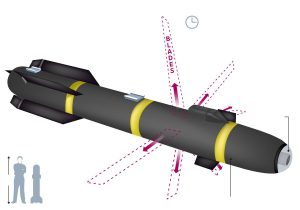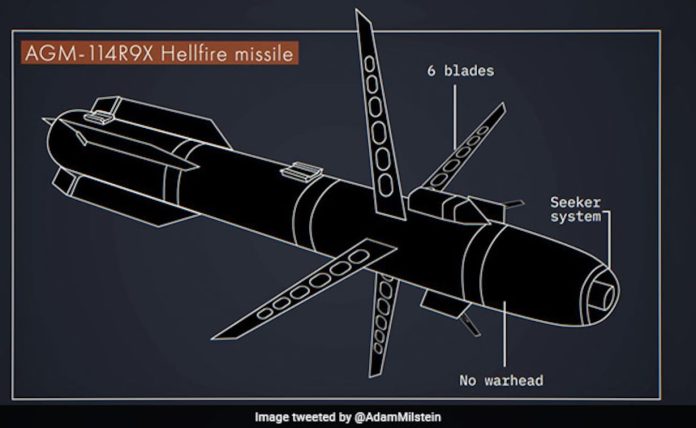On July 31, 2022, al-Qaeda leader and architect behind many of the terror group’s attacks abroad, Ayman Mohammed Rabie al-Zawahiri, was killed during a CIA drone strike in Kabul, Afghanistan. The United States Department of Defense reported that two Hellfire missiles were used to carry out the strike, which resulted in no other casualties. Immediately after the strike, photos began to emerge online of the house Zawahiri was staying at, which showed minimal damage to the structure, as well as no signs of an explosion. It was later reported that Zawahiri was on the balcony of the building when he was killed, so this raises the question: What missile can kill a target and seemingly not result in any other collateral damage nearby? Taliban officials were quick to cordon off the area and so far there are no photos of the strike’s aftermath, however, details of the strike suggest that conventional, explosives-based warheads were not used, but rather a kinetic missile obscurely known as the R9X.
This is the house in #Kabul where Al Qaeda leader al Zawahiri was staying and killed in a US drone attack.
Local journalists say that #Taliban prevents the media from getting near this area.#AlQaeda #Afghanistan pic.twitter.com/jWn6F1TWcw
— Mohammad Natiq (@natiqmalikzada) August 2, 2022
As far as the United States’ military and government are concerned, the R9X does not officially exist, however, strikes over the past several years have revealed details about the workings of the missile and how it is utilized. Dubbed the “flying ginsu” and the “ninja bomb,” the R9X appears to be a modified AGM-114 Hellfire missile retrofitted with six metal blades that deploy outwards moments before impact. As stated before, the R9X does not use the typical 20 lb. explosive payload of a regular Hellfire, but rather utilizes kinetic energy to destroy its target. The force generated by the missile not only crushes its target, but the blades completely eviscerate whatever is below. The use of kinetic energy also reduces the risk of unintended civilian casualties and collateral damage, which is why the weapon has been increasingly used on high value targets in densely populated urban areas where conventional explosives would not be a viable option.

More specific details of the missile were made public with a 2019 investigation by the Wall Street Journal (WSJ), citing anonymous current and former military and government officials. The WSJ reported that the development of the missile came about in 2011 due to pressure from the Obama Administration to reduce the risk of civilian casualties during air strike operations in the Middle East and Africa. This was because militant groups would increasingly hide in the civilian population of urban areas, setting up bases of operations near schools and hospitals to reduce their chances of being hit by airstrikes. The R9X is used under specific circumstances to be effective against the enemy: where a high value target has been identified traveling in a vehicle, usually alone. However, the missile is so accurate it can kill a passenger of a vehicle without harming the rest, an anonymous defense official told the WSJ. Since the missile does not carry an explosive warhead, it is ineffective against a group of targets or buildings.
The use of the R9X has been limited in its operational history compared to more traditional strike packages. Listed chronologically below are suspected uses of the R9X based on photographic evidence at the scene of the strike since the U.S. government or military has officially commented on what type of missile was used.
February 26, 2017- The first suspected instance of the weapon being used was during a strike that killed Ahmad Hasan Abu Khayr al-Masri, the general deputy of al-Qaeda, in Idlib, Syria. Anonymous government officials told American media sources that the Central Intelligence Agency carried out the strike, but the agency never confirmed this. Like other R9X strikes, the vehicle was mostly intact except for a hole in its roof. There was no reported collateral damage.
HUGE news via source:
Al-Qaeda deputy leader Abu al-Khayr al-Masri has been killed in a U.S drone strike near Al-Mastoumeh in #Idlib. pic.twitter.com/RORT6sU8Sj
— Charles Lister (@Charles_Lister) February 26, 2017
August 28, 2018- Islamic State commander Walid Bu Hariba was killed during a strike in Bani Walid, Libya. The U.S. Africa Command confirmed that an airstrike took place at the same date and location as the one that killed Walid, but did not provide any other details or confirm who the strike targeted. Photographs of the site of the strike shows a white pick-up truck covered in blood, with its windows covered by cardboard or tarps. However, it is clear that portions of the roof on the driver’s side is caved in from a projectile. There are no signs of burns or an explosion. There was reported collateral damage.
??? ???? ???? ????? ????? ???????? ?????? #???_???? ???? ?????? ????? ?? ??? ?????? 2002 ??????? ??? ????? #?????_??????. pic.twitter.com/QyoJuY5DIr
— ???? ??????? (@Mohaeljazwey) August 28, 2018
January 1, 2019- Jamal al-Badawi, the al-Qaeda “mastermind” behind the bombing of the USS Cole, was killed during a strike in Ma’Rib, Yemen. Anonymous American officials told the WSJ the R9X was used during this strike. No photos were released with the strike.
December 3, 2019- Hayat Tahrir al-Sham (HTS) trainer Abu Ahmed al-Muhajir was killed during a strike in Idlib, Syria, near the town of Atme. Al-Sham was known for his role in training members of “the Red Bands,” HTS’ specialized fighting force used to attack pro-Assad targets in government held areas of Syria. In this instance, the damage the missile can do is shown clearly in the video. The roof is completely caved in and the inside of the vehicle is painted with the remains of al-Sham. There was reported collateral damage.
I think this is the video of what's left of man killed by the Coalition's "Ninja Missile", the video was appently recorded somewhere near Atima (#Idlib) very close to the Turkish border. Look at the glass windows!#ISIS #AlQaeda pic.twitter.com/mm7vMSgVnp
— ONC3X (@ONC3X) December 4, 2019
December 22, 2019- Hurras al-Din commander and former al-Qaeda leader Abu Khadija al-Urdani, also known as Bilal Khuraisat, was killed during a strike outside the town of Termanin in Syria’s Idlib province. Like the other instances, the vehicle remains intact except for the hole in the roof created by the missile. There was reported collateral damage.
NEW – Senior #AlQaeda veteran Bilal Khuraisat was killed today in a US strike in Termanin, #Idlib. He’d wavered in/out of Huras al-Din in recent months, but was AQC through-and-through.
As seems to be standard practice now, it appears an R9X “Flying Ginsu” missile was used. pic.twitter.com/KTEIXhPVyp
— Charles Lister (@Charles_Lister) December 22, 2019
January 12, 2020- Taliban financial officer Muhibullah Sher Wali Khan is killed during a strike in Kunduz Afghanistan. Photographs of the strike scene show a nearly intact vehicle except for a hole in the roof. There was reported collateral damage.
In an air strike we killed a Pakistani national & the Taliban terrorists financial officer Muhibullah Sher Wali Khan while he was driving through Imam Saheb District in Kunduz province.
Pakistan Main Koyee Sharm Bacha Hain? pic.twitter.com/RJErGlbfKY
— Rahman Rahmani (@rahmanrahmanee) June 30, 2020
June 14, 2020- A strike killed Hurras Al-Din Commanders Qassam al-Urduni and Bilal al-Sanaani in Idlib, Syria.. Photographs of the scene also showed a mostly intact vehicle with a hole in its roof, coated in blood on the inside. Additional photographs also showed the remains of the missile and its blades, further suggesting the R9X was involved. There was reported collateral damage.
#Syrie nouvelle frappe US #R9X à #Idleb « un mort et un blessé » pic.twitter.com/KE4cmhTcLh
— Wassim Nasr (@SimNasr) June 14, 2020
August 13, 2020- The Syrian Observatory for Human Rights reported that an airstrike near the town of Sarmada in Syria’s Idlib province killed Abu Yahya al-Uzbeki, a militant trainer associated with the al-Qaeda linked Hurras Al-Din. Photographs taken at the scene show the militant’s mostly intact vehicle with a gaping hole where the roof meets the windshield. Additional photos show a gruesome sight inside the vehicle, where nothing but blood and guts paint the seating and doors. Despite it being an airstrike, there were no burn marks or signs of an explosion.There was reported collateral damage.
A drone of the coalition carried out a strike on the car in which Abu Yahya al-Uzbeki was riding. pic.twitter.com/qSYPUEcTRL
— Oleg Blokhin (@0legblokhin) August 13, 2020
April 5, 2021- A Coalition airstrike has killed senior Islamic State leader Omar Abd al-Fatah near Serê Kaniyê/ Ras Al-Ain, northern Syria, which is an area controlled by Turkish backed militant groups. The Violations Documentation Center in Syria (VDC) released a report on Monday that stated “A drone allegedly affiliated with the Global Coalition targeted a car of the leader Omar Abd al-Fatah, and killed him in the village of al-Dahman in the countryside of Sere Kaniye,” adding that “We could not find out his real name, but he holds an ID issued by Sere Kaniye local council, which is affiliated with the Turkish-backed Syrian Interim Government and the National Coalition for Syrian Revolution and Opposition Forces.” The state of the vehicle was not consistent with that of a conventional strike. There was reported collateral damage.
#Serê_Kaniyê: Local media: Unknown aircraft targeted a vehicle near the village of Al-Sarli, Turkish occupied Serê Kaniyê countryside, killing the driver. pic.twitter.com/qTDTRs9HEs
— Rojava Network (@RojavaNetwork) April 4, 2021
The R9X has shown itself to be superior in eliminating high value targets while also reducing the risk of collateral damage. There has not been an instance of collateral damage in any of the suspected uses of the R9X, making it a critical asset in eliminating targets in densely populated areas. While never officially confirmed, mounting evidence shows an increased use of the weapon, making it clear that militant groups are no longer safe traveling in highly populated civilian areas. The effectiveness of the R9X opens up the possibility of further reliance on kinetic weapons systems, however, all suspected use cases have been limited to counter terrorism operations and its effectivness on a conventional battlefield remains unknown. While mostly limited to vehicles and other soft targets, kinetic weapons systems can be expanded to take on larger roles in eliminating larger, more populated targets such as buildings or training camps. Overall, the R9X has the potential to become the main weapon when eliminating HTVs, paving the way for more precise airstrikes that eliminate the risk of collateral damage.



